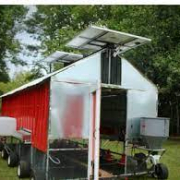Chiktopia: Solar Grazing with Automated Chicken Coops
By Allen Puckett, NCAT Technical Writer
August 2023
In Ballground, Georgia, Jeffrey Whitmire and Chris Ayers, owners and operators of Chiktopia, are making use of an innovative solar technology that allows them to automate pastured poultry production while also practicing regenerative agriculture. Whitmire and Ayers, both students at the University of Georgia, produce and use fully automated solar-powered chicken coops on their operation, which they also sell to other farmers. In addition, Chicktopia provides regenerative grazing services to farmers.
These solar-powered chicken coops assist in building the topsoil (regenerative agriculture) using chickens. The self-moving, automated chicken coops makes spreading manure and flock rotations much easier for farmers and results in healthier soil with a higher level of organic matter. Chiktopia suggests that automated equipment such as these solar chicken coops are mandatory for regenerative agriculture in the future.
“At Chiktopia we believe sustainable farming practices are not only what are best for the planet but are also what create the happiest animals and the healthiest food. We help farmers minimize labor and maximize management.
Our automated chicken coops use renewable energy systems, which automate the majority of the labor in the pastured-poultry process. Whether it be for broilers or egg-layers our coop will help save you time and labor.” – Chiktopia
Chiktopia aims to help build a more resilient food system across the United States using pasture-raised poultry, says Whitmire.
The Regenerative Process
If a farmer wants a section of land to be converted into a regenerative crop farm, Chiktopia provides that service and process. The first step in the process is to put egg-laying hens on the land in the mobile, solar-powered coops. Once the hens are rotated through the whole pasture, dairy cows are then put on the land to spread more manure. This last step of the grazing process allows the soil to sustain more vegetation through increased microbe quality and carbon sequestration. This improvement in soil health is known as regenerative grazing.
Traditional Chicken Coops
A traditional chicken coop is made of steel and must be manually lifted or moved using a handle or trailer hitch on one end. This requires much more manual labor than having an automated coop. Moving these traditional coops causes the pasture to be damaged when chickens spend too much time in one spot. The mobility of the new solar-powered coop keeps the chickens from destroying the pasture and allows the organic matter in the soil to regenerate.
Solar-Powered Chicken Coops
The solar-powered chicken coops are equipped with an automated temperature-control system, automated chicken feeder, sun-tracking solar array system, automated pressurized watering system, automated egg collector, and even heat lamps for young chicks. These coops have a traditional hitch for farmers who might prefer moving the coop with ATVs or trucks, but they can also be easily moved with a handheld remote control.
When the coop moves, the birds don’t seem to mind at all. On the outside of the coup is an electrified perimeter fence that keeps the chickens in and predators out. When the hens are first put on a specific site, they spend a couple days in the coop getting comfortable with the new location, says Whitmire. They are then let out of the coop into the fencing area where they can roam.
The floor of the mobile coop is lined with plastic netting that allows the bird manure to fall to the pasture below. Feeders are aligned on the two sides of the coop above the netting where the birds tend to spend most of their time. When they aren’t feeding, there is a ladder in the center of the coop that allows the birds to get up near the ceiling and roost on installments designed for chicken roosting.
These automated, solar-powered chicken coops are available to order on Chiktopia’s website. Depending on the needs of the farmer and the design of the coop, costs can vary, ranging from $8,000 to $20,000. One coop created by Chiktopia houses up to 400 birds.
Predation Prevention and Shelter
These coops provide effective predation prevention. The sturdy cover provided by the coop protects hens from hawks and other predatory birds when they are inside. The coop’s design also reliably provides protection from harsh weather and other conditions that may make the birds uncomfortable or unsafe.
“We keep our birds protected through using strong materials on the coop and an electrified fence. Solar panels also reflect light at raptors.” – Chiktopia
Future Improvements
Chiktopia plans to make improvements to their coops, including a rainwater diverter that puts water directly into the watering tank that will be available to the chickens.
“Our birds have never been happier, and collecting eggs has never been easier! Daily movements are easy because the coop moves itself.” We were not able to move our birds on pasture before we had an automated Chiktopia coop.” – Chiktopia customer



